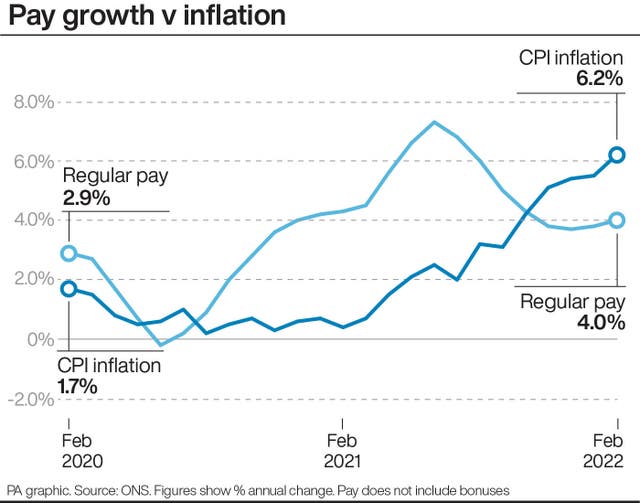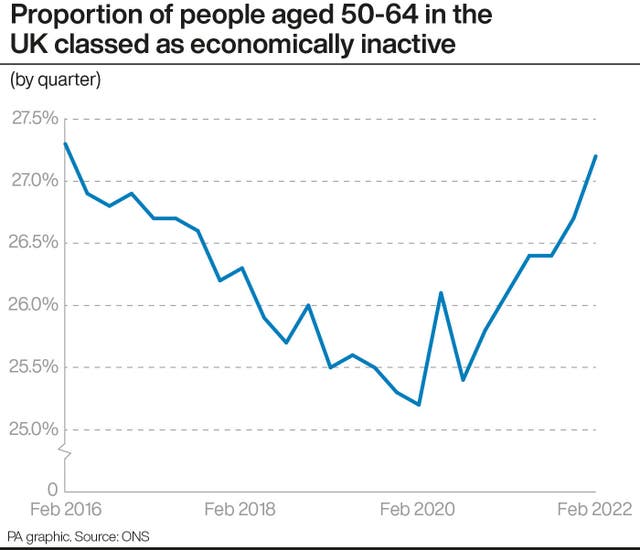
Clive Bull 1am - 4am
12 April 2022, 12:34

The Office for National Statistics said regular pay excluding bonuses tumbled 1.8% in the three months to February when taking inflation into account.
UK workers suffered the biggest fall in their real pay for nearly nine years as the cost-of-living squeeze tightened, according to official figures.
The Office for National Statistics (ONS) said regular pay excluding bonuses tumbled 1.8% in the three months to February when taking soaring inflation into account, as measured by the Consumer Prices Index (CPI) – the steepest fall since August to October 2013.
The ONS said real pay was now “falling noticeably”, with figures for February alone showing regular wages dropped 2.1% after inflation, which was the biggest drop since August 2013, the ONS added.

When compared with CPIH, which includes owner occupiers’ housing costs and is the ONS’s preferred measure of inflation, real regular wages fell 1% in the three months to February.
While pay rose 4% in the quarter, it was far outstripped by inflation and experts have warned wages will lag even further behind rising prices this year as inflation is expected to rocket in the autumn.
Chancellor Rishi Sunak said the Government was “helping to cushion the impacts of global price rises through more then £22 billion of support for the cost of living this financial year”.
But Labour hit out at the Government’s move to press ahead with this month’s tax rises.
Headline indicators for the UK labour market for December 2021 to February 2022 show that
▪️ employment was 75.5%▪️ unemployment was 3.8%▪️ economic inactivity was 21.4%
➡️ https://t.co/QCJV39NTrS pic.twitter.com/pOxpviFeKq
— Office for National Statistics (ONS) (@ONS) April 12, 2022
Pat McFadden, Labour’s shadow chief secretary to the Treasury, said Mr Sunak has “decided to make Britain the only major economy to land working people with higher taxes in the midst of a cost-of-living crisis.”
The latest ONS data revealed the unemployment rate fell further below levels seen before the pandemic struck, at 3.8% in the three months to February – the lowest since December 2019 and down from 3.9% in the previous three-months.
It has not been lower than this since 1974.

There were 86,000 fewer jobless Britons at 1.3 million in the quarter to February, while those in employment rose 10,000 to 32.5 million.
More timely pay as you earn (PAYE) data showed there was another rise in the number of UK workers on payrolls last month, up by 35,000 between February and March to 29.6 million.
There were an average of 1.288 million job vacancies across January to March 2022, up from 1.238 million in the previous quarter https://t.co/U8h1PEutCI pic.twitter.com/SKl4rGLKM2
— Office for National Statistics (ONS) (@ONS) April 12, 2022
But there were signs of easing demand for staff, with this marking the smallest monthly increase since February last year.
Vacancies also saw the smallest rise since February to April 2021, up 50,200, but hit another record high of 1.29 million in January to March.
And a shrinking labour market, due mostly to older workers choosing to retire early throughout the pandemic, has also seen those classed as economically inactive rise by 76,000 in the quarter to 8.9 million.

The figures come amid forecasts that inflation, already at 6.2%, will peak at nearly 9% this autumn, with official data on Wednesday set to show another steep rise in the CPI.
The latest data from the ONS marks the calm before the storm, ahead of April’s energy cap rise, council tax bills increase and the national insurance contribution rise.
The UK’s economic forecasters, the Office for Budget Responsibility (OBR), recently warned that households will suffer the biggest fall in real incomes since records began in 1956, with a drop of more than 2.2% this year.
Ellie Henderson at Investec Economics cautioned the jobs market may slow as cost pressures mount.
“Although there is currently a vast amount of vacancies, hiring confidence can quickly be dented if the high inflationary environment results in households cutting back expenditure while firms struggle with rising costs,” she said.